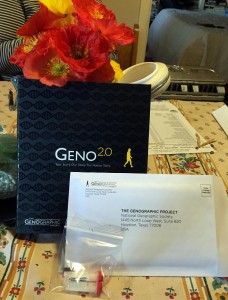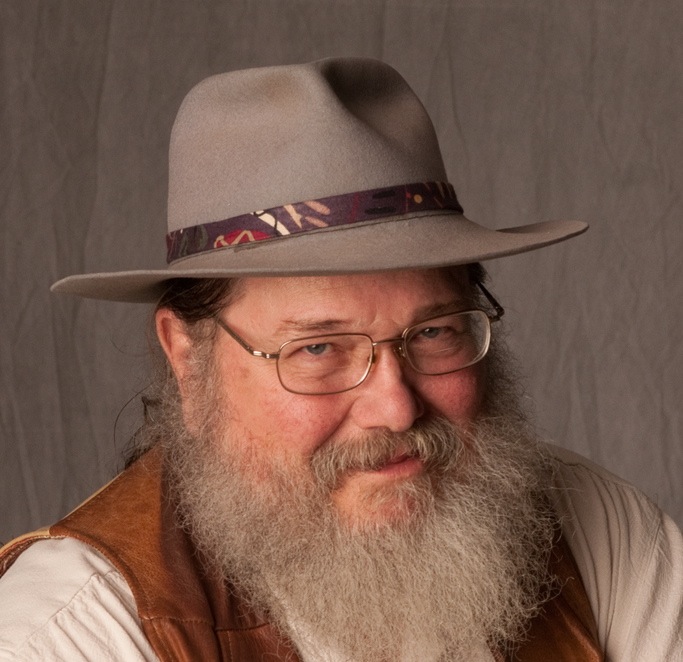
National Geographic’s Geno 2.0 Next Generation test kit, part of their Genographic Project. Photo by the author
Some of my ancestors on my Daddy’s side came out of Tennessee in the 1700s and for more than 50 years worked their way north across Kentucky to Illinois growing bloody butcher corn and Jacob’s beans in patches of rich soil they hacked from the endless forest. They ate game and hunted their own herds of half-wild pigs that ran free and fattened on acorns. Sylvester Norris settled along Crane Crick near where Peoria is today. His wife didn’t long survive giving birth to my grandfather on Jan. 1, 1845. His birthdate dictated his name: Henry “New Years” Norris. Henry was in his teens when the widowed Sylvester’s eye was taken by a young red haired beauty that he courted and wed. Here the family story forks.
One version says young Henry got involved with his new stepmother in a socially unacceptable way and he had to leave town in the middle of the night. The alternate story, which I heard when I was older, was that Grandpa found his new stepmother-to-be wicked and cruel. She tried to poison him by putting lye, a very strong alkaline solution which burns like an acid, in his food. He suffered a dreadful wound to his jaw which troubled him for years. This was why he always wore a full beard to cover the scars. Whatever the motivation to leave, he didn’t wait ‘til warm weather, but strapped on his skates and stroked down the ice-coated Illinois River for more than 75 miles to begin his journey to Texas. That’s where people went in those days. He became an accomplished carpenter and furniture maker around Parker County and built homes and churches. He was installing desks at the Harmony School one day when one of the older girls persisted in “making eyes” at him. She would become my grandma Griffith, a stalwart woman who brooked no nonsense; she was known to discipline her children by holding their heads between her knees and delivering blows with her brogan shoe. When Henry Brantley, my father, was 10 he followed the wheat harvest with a thresher crew. With his earnings he told me he bought his mother a good winter coat and for himself a shotgun. He spoke of apprenticing in his uncle’s blacksmith shop when he was 12 and learning to work on wagons and later Model A Fords. He hunted squirrels with a single-shot .22-caliber rifle. He told of the neighbor’s wife, whose bandaged neck was explained as an injury sustained when she walked into the clothesline in the dark. Her son who was my dad’s age told him he had found his drunken father straddling his mother in the back yard, butcher knife in hand.
Mama’s father, Papa Kinser, was a one-armed farmer. He took onions, potatoes and radishes to market in a horse-drawn wagon. He had a fine writing hand and often was asked to decorate the blackboard at church with colored chalk. He chose for his wife a young Cherokee woman who appeared from the east Texas autumn haze. She had led her remnant family out of Missouri and across Arkansas. My mother Alice loved to ramble the woods as a child and knew where the first Johnny Jump Ups appeared in the spring and where all the bird nests were. Sixty years later she would write: “I dreamed of being like the Indians.” She was 15 when Henry Brantley Norris, 21, came courting. She once told my wife that Henry showed up one day in his model T, showed her a marriage license, and told her that because he had the license they had to get married. She might have gotten a second opinion.
I was the next youngest and best looking of the 11 children produced by this arrangement. I grew up listening to my parents telling stories of the people and events that came before. My mother grew up in a place between the meetings of two streams, and when they flooded, her home was surrounded by water. She recounted her brothers swimming to the mailbox and returning with the mail tight in their teeth. Her brother Ernest found a baby pig with its head stuck in a can. He raised it and traded it for a horse and then traded the horse for a car. This story had all of the charm of a folk tale for me.
I absorbed these stories and they became warp and woof of the fabric of my identity. I could see them as clearly as if they had happened to me. I was shocked the first time I told someone my grandmother was Cherokee and they responded, “I’ll bet she was a princess!” But there were no family records to support the claim, no tribal rolls to reference. It was a time and place before it was cool to be Indian. Through the years individuals in the family have done genealogical research that established some branches extending back to 13th century Germany, and even secured a berth for an ancestor on the Mayflower.
Since DNA testing became available on the consumer market I have been intrigued. The ads show colorful maps of the world with arrows indicating migratory routes erupting out of Africa. I settled on National Geographic’s Genographic Project. The kit arrived this week. I vigorously wiped my cheeks with the sterile swab and deposited the tips in little specimen jars labeled with my barcoded stickers. What kind of cocktail of racial DNA am I comprised of? A shot each of English, Irish, German and Cherokee with a twist of Neanderthal and shaken vigorously with family stories? I sent them off by return post and now my job is to patiently wait until I’m notified by email that the results are ready for my scrutiny. Then you may address me as Prince Sweating Tractor.
Tony Norris is a working musician, storyteller and folklorist with a writing habit. He’s called Flagstaff home for 30-plus years. Visit his website at www.tonynorris.com.

